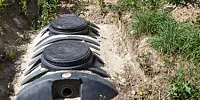-
Do I need to remove a disused septic tank in France after connecting to the mains?
Safety is the number one priority, says Sarah Bright-Thomas of Bright Avocats
-
How to finance a septic tank in France
The limited options include several types of loans and some discounts
-
Septic tanks expose difference between law and reality in France
The tanks can reveal stark differences between French and British laws... and the attitude of homeowners towards them
Contrôle of Septic tanks and SPANCs...
Around 15% of homes in France are not linked up to a public sewerage system and instead depend on their own installation, usually a septic tank and a drainage system, called ANC, Assainissement Non Collectif .

In rural areas, this figure can rise to 80% and there are strict regulations to ensure that ANCs do not become health or environmental hazards.
It is the commune’s responsibility to enforce the regulations and most do this through a national public body called the Service Public d’Assainissement Non Collectif, or SPANC, which helps and advises individuals and carries out checks (contrôles).
Many communes or the communauté de communes employ technicians to carry out SPANC work for them while others use a private company to complete this role.
By law the commune must ensure each ANC is checked at least once every 10 years, but this can be more frequent. In the rural commune where I live, and where 80% of households have an ANC, visits are carried out every eight years.
It is up to the commune to contact the owner and make an appointment, and the owner must let the technician on to their land. The owner pays for this visit in one way or another: often the commune has an agreement with the water company and the charge of about €80 is added to your water bill.
Jean-Baptiste Fraysse, my area’s technician, in Pays de Fénelon, Dordogne, says that in 80% of cases the owner will have some work to do to meet regulations. “Usually it does not involve a great deal of work. It could be just adding an inspection window.
“If the system is old but complies with the regulations in place when it was installed, and functions correctly we let it be. However, if there is no ANC, or if it is in a very poor state, the owner may have to upgrade or renew the system.”
Any work, small or major, must be carried out within four years of the visit, or the owner will be liable for a fine. There will be another visit to check the work has been done, with the owner billed for this.
Once your installation is approved you will be given a certificate on the diagnostic assainissement non collectif which becomes part of the Dossier de Diagnostic Technique (DDT) to be supplied if you want to sell your house.
If you have no certificate, you will have to contact the commune to check the ANC when you put your house up for sale.
Any work to be done must be done within one year from the signing of the Acte de Vente.
Usually the purchaser does the work, so as not to slow down the sale, but negotiates a house price cut to compensate.
You are free to choose who will do the work, and the commune can supply a list of firms.
If you need a new ANC, your SPANC technician can give advice. You are not bound to follow this, as long as your choice falls within legal requirements, but he / she is an expert and can advise what size you need, the best site and best adapted drainage system for your land and the pros and cons of different systems.
If you plan a new build they will visit to ensure you can install a system on the land, before permission is given.
In our case, Mr Fraysse went out of his way to advise us and also helped apply for a grant.
Financial help is available either by a 0% Eco-loan (Eco-prêt à taux zéro) available for main homes built before 1990, and up to a maximum of €10,000. Ask your SPANC advisor for a form.
Grants are also available for very-low income households via the Agence Nationale pour l’Amélioration de l’Habitat.
France’s six Agence de l’Eau, set up to reduce pollution and protect water resources may also give grants depending on situation and locality.
I was able to get a grant as we bought our house before 1996 and our ANC drained on to our neighbour’s land directly from the septic tank. It was high time to get it sorted out.
We will get a maximum of €4,000, but Mr Fraysse warns there are fewer properties which fulfil these conditions.
Fosse, compact, micro or phyto...
There are more than 100 authorised types of ANC and they fall into four categories, with the most common being a septic tank plus a drainage system. A fosse septique deals with waste from toilets only. A fosse toutes eaux deals with domestic water and toilet water.
Drainage depends on the amount of land you have and its geography, and can be a series of perforated pipes in trenches or a filter bed of layers of gravel and sand. Over time, solids will build up in the tank and they must be emptied around once every four years for a main home.
When there is very little land you can use either a Compact system or a Micro-station d’Epuration, but these require more maintenance and may need emptying every year.
The fourth system is Phytoépuration and uses plants to filter the water. There is only one company, Aquatiris, authorised to install this system. SPANC technician Jean-Baptiste Fraysse says they work well but are more expensive at around €10,000 for a three-bedroom house while a classic septic tank system will cost between €5-6,000 for a basic model of the same size.
























